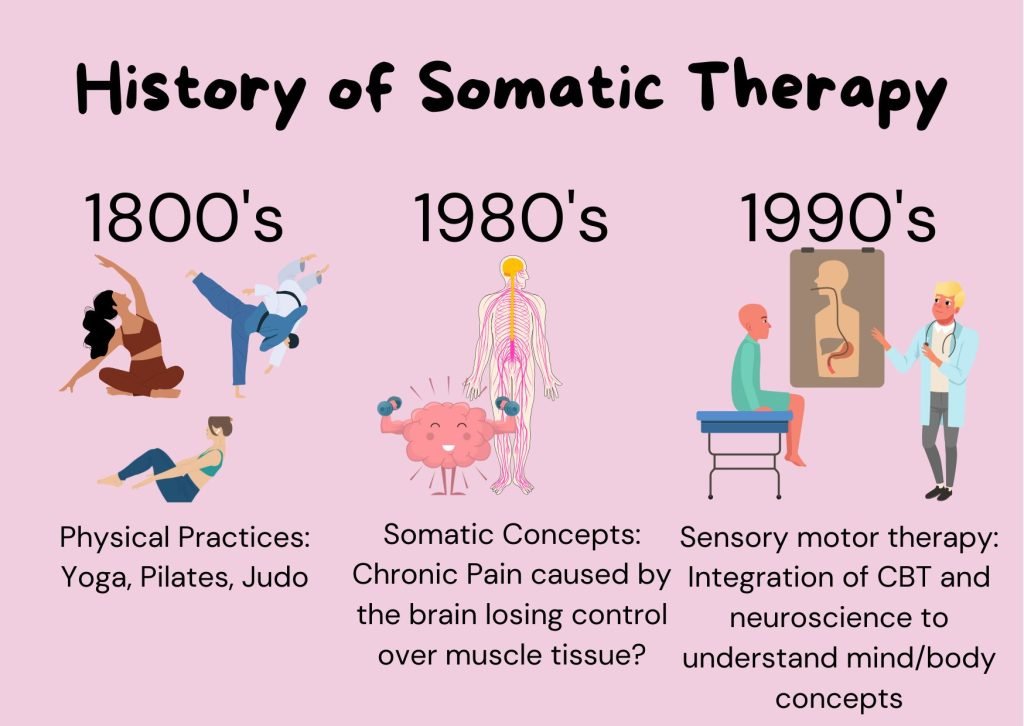In contrast to traditional cognitive-behavioral therapy (CBT) that primarily addresses the mind, somatic therapy integrates body-centered practices like dance, breath work, and meditation to facilitate emotional well-being. Somatic experiencing therapy also incorporates talk therapy and mind-body exercises.
I have tried some of these therapies and found it really useful.

What Somatic Therapy Can Help With
Anyone can try somatic therapy as an alternative to conventional talk therapy. It is used for a variety of health issues.
Mental health issues that somatic therapy is used for include:
- PTSD
- Anxiety
- Addiction
- Grief
- Depression
- Stress
Physically, somatic therapy may assist with:
- Chronic pain
- Digestive disorders
- Sexual dysfunction
Because of its focuses on grounding and mindfulness, this therapy can be an effective option for anyone looking to get more in touch with themselves and their experiences in life.
Types of Somatic Therapy
Beyond the standard somatic therapy, numerous subgroups use its framework in specific ways. These include:
- Dance therapy is a form of somatic therapy
- Sensorimotor psychotherapy: A comprehensive therapy that uses the body as both a source of information and intervention targets.
- The Hakomi Method: Psychotherapy that integrates scientific, psychological, and spiritual sources, focusing on four core concepts: gentleness, nonviolence, compassion, and mindfulness.
- Bioenergetic analysis: Body-psychotherapy that combines bodily, analytic, and relational work based on understanding energy.
- Biodynamic psychotherapy: A combination of allopathic (medical) and holistic therapy modalities that include physical massage by the practitioner
- Brainspotting: In addition to mind and bodywork, this therapy incorporates eye positioning to retrain emotional reactions.
Techniques
Somatic therapy operates off the idea that what happens to you in your life is stored not only in your mind but also in your body.
By focusing on both the physical sensations in your body and the discussion of your problems, it is a comprehensive approach to therapy. Somatic therapy techniques include:
- Developing more awareness of your body and its sensations
- Calling upon emotional resources
- Grounding
- Encouraging detailed descriptions
- Movement, including acting out of physical feelings
- Learning tools to calm oneself
- Alternating focus between something stressful and something not stressful to help release tension
- Replaying past situations with new physical tools
- Emotional release
- Strengthening boundaries
Benefits of Somatic Therapy

1. Improve Your Body Awareness
The goal of somatic therapy is to make the body and mind more conscious. Somatic treatment can focus on deeply ingrained trauma held in the neurological system while traditional talk therapy can help people work through mental and emotional concerns.
2. Transform And Release Trauma
Somatic Therapy helps many people reconnect with their bodies and has been shown to be effective in helping people with PTSD manage their symptoms.
Those who have had physical trauma, such as sexual or domestic abuse, may find this particularly challenging. Utilising the idea that trauma is stored in the body, somatic therapy tries to convert this dysregulation into regulation.
It emphasises the impact of thoughts and reactions on the way your body responds to triggers and trauma. Somatic Therapy can help patients release trauma by raising awareness of where it is held in the body, whether through mindfulness or mindful activities like yoga or tai chi.
3. Create The Resources To Help You Grow
Trauma can prevent us from leading satisfying lives. But Somatic Therapy can help us overcome the psychological, emotional, and physical barriers that stand in the way of improving our mental health.
While somatic experiencing gives us the abilities to process and deal with our unprocessed emotions, it also helps us identify how our body feels and where those emotions are located.
You can use somatic practices like grounding and resourcing whenever you need to relax yourself after coming into contact with a trigger because many of them can be done at home or at work.
4. Unwind Tension
To aid in the body’s release of tension held in place as a result of trauma is one of the goals of somatic experiencing. This can be assisted by mindful somatic activities, which increase awareness of the body and enable people to identify tense or painful places.
People who have previously experienced trauma may be struggling with emotional dysregulation, which can result in tightness in the body. A component of this is the freeze response, a defense mechanism that people use instead of running or fighting when they feel threatened.
The brain is unable to determine when they are no longer in danger. As a result, the freeze response persists, which causes symptoms including bewilderment, alienation, and difficulty moving.
5. Effective Symptom Treatment
Somatic experience can teach people improved thought patterns and assist to rewire the brain to produce a beneficial balance since it focuses on body sensations and controlling the emotional system.
Conclusion
Somatic therapy, also known as somatic experiencing therapy, helps patients by focusing on physical sensations rather than just talking about problems. Therapists guide patients through exercises like breath work, meditation, and massage to address mind-body connections.
As with any form of therapy, it’s essential to be in an emotional and mental place where you have the time and energy to process complex feelings.
If you’re doing somatic therapy in person, touch is often involved. Because of that, it’s wise to ensure you don’t mind being touched by another person.
Somatic therapy is not considered to have any risks that are specific or unique to its format.



